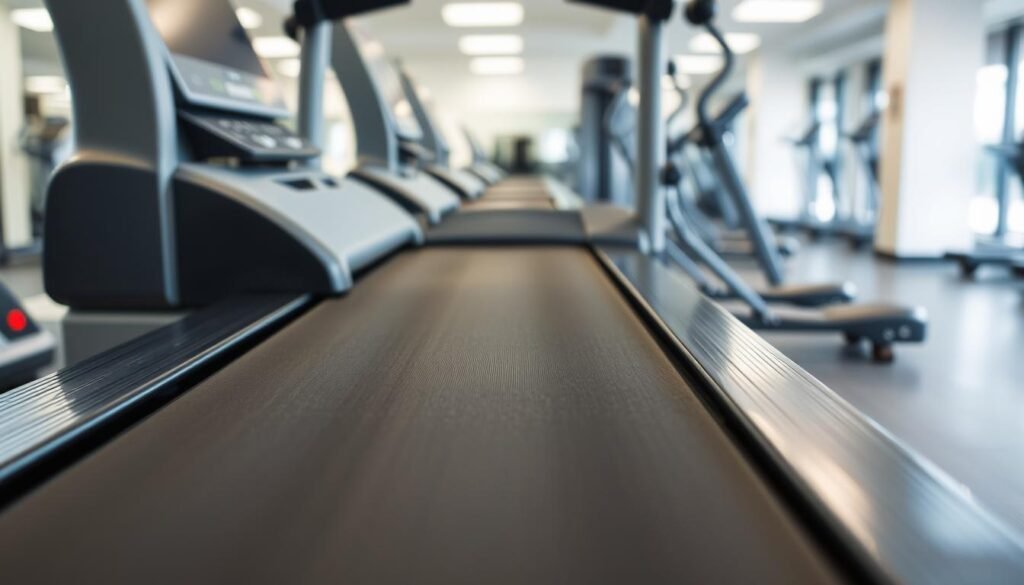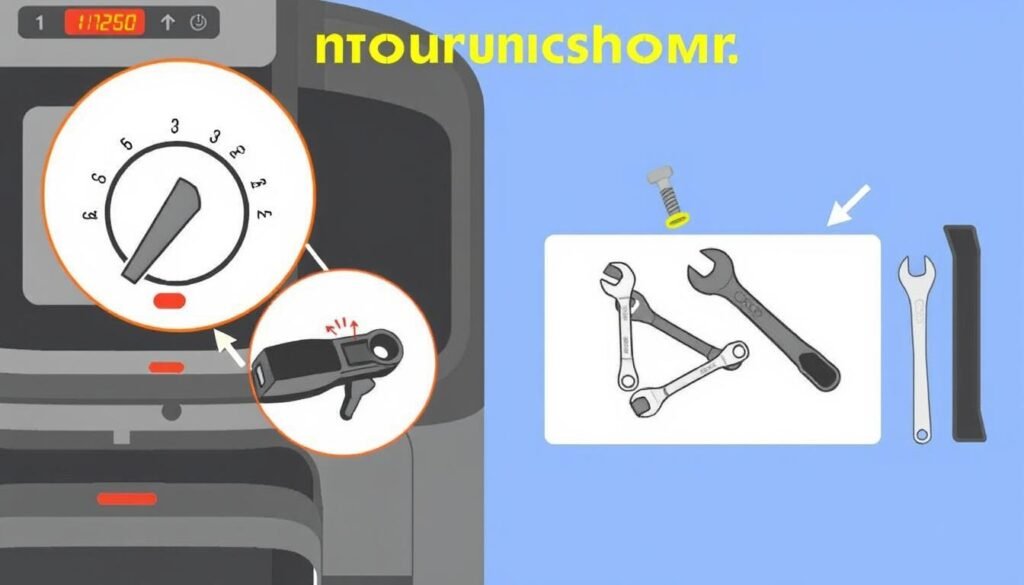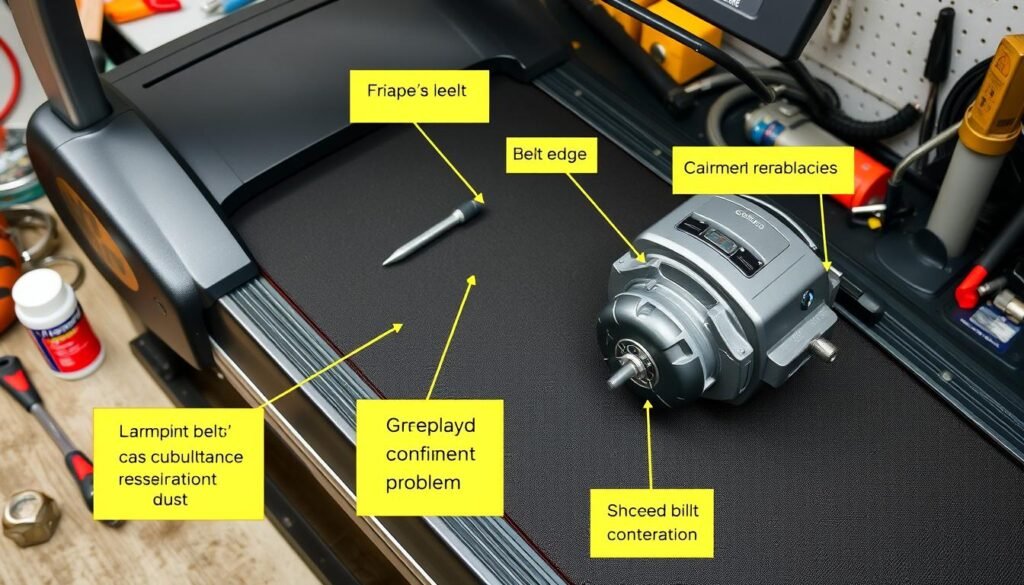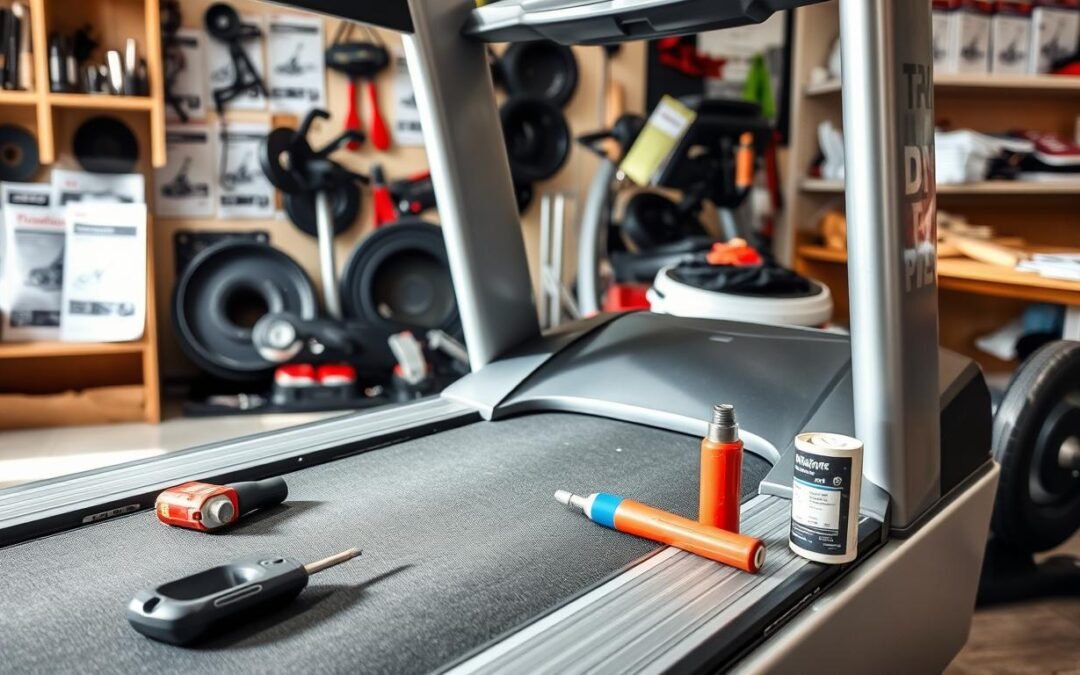As a fitness enthusiast, you know how frustrating it can be to encounter common treadmill problems. These issues can disrupt your workout routine. But, with the right guidance, you can get back on track quickly. In this article, we’ll cover common treadmill problems and how to fix them. We’ll also provide you with valuable treadmill repair tips to keep your machine in top condition.
Whether you’re dealing with mechanical issues or electrical problems, our guide will help you. We’ll walk you through identifying and resolving common treadmill problems. From troubleshooting to maintenance and repair, we’ve got you covered. With our expert advice, you’ll be able to identify and fix common issues. This ensures your treadmill continues to function smoothly and efficiently.
By following our treadmill repair tips and troubleshooting guide, you’ll be able to address common issues. This way, you can get back to your fitness routine without any disruptions. Our goal is to provide you with the knowledge and expertise to tackle common treadmill problems. This way, you can focus on achieving your fitness goals.
Key Takeaways
- Identify common treadmill problems and their causes
- Learn how to troubleshoot and repair your treadmill
- Understand the importance of regular maintenance
- Discover valuable treadmill repair tips and tricks
- Get back to your fitness routine with minimal disruptions
- Keep your treadmill in top condition with our expert guidance
Understanding Your Treadmill’s Warning Signs
Using your treadmill regularly can cause wear and tear. It’s important to know the warning signs of problems. A treadmill maintenance guide can help you spot these signs early and prevent bigger issues.
With a treadmill troubleshooting guide, you can find and fix common problems. DIY treadmill repairs can save you money. But, always follow safety rules and guidelines.
Identifying Unusual Sounds
Unusual sounds mean something might be wrong with your treadmill. Look out for grinding, squeaking, or thumping noises.
Recognizing Performance Issues
Slow or uneven belt performance can signal a problem. It could be with the motor or control system. Fixing these issues quickly is key to avoiding more damage.
Reading Error Codes
Modern treadmills show error codes to help diagnose problems. Your treadmill maintenance guide or treadmill troubleshooting guide can teach you how to read and understand these codes.
| Warning Sign | Possible Cause | Recommended Action |
|---|---|---|
| Unusual sounds | Worn or damaged belt | Replace the belt or consult a treadmill maintenance guide |
| Performance issues | Motor or control system problem | Consult a treadmill troubleshooting guide or contact a professional |
| Error codes | Software or hardware issue | Consult your treadmill maintenance guide or contact the manufacturer |
The Belt Won’t Move: Causes and Solutions
Dealing with common treadmill issues can be really frustrating. A belt that won’t move is a big problem. It might be due to a bad motor, a worn-out belt, or rollers that aren’t aligned right. To fix it, you need to find out why it’s happening and then fix it.
Start by looking at the belt and rollers for any damage. Check for cracks or frays on the belt and make sure the rollers are straight. If you see any problems, you might need to fix or replace parts. Also, lubricating the belt and rollers can help reduce friction and prevent more damage.
Other reasons for a stuck belt could be a broken motor control board or a faulty display panel. If this is the case, you might need to look at the user manual or get help from a pro. Finding and fixing the real problem will help you get back to working out quickly.
To avoid this problem in the future, keep your treadmill in good shape. Clean the belt and rollers, lubricate the parts that move, and check the display for errors. Regular maintenance can help prevent common treadmill issues and keep your treadmill working well for a long time.
| Cause | Solution |
|---|---|
| Faulty motor | Replace the motor |
| Worn-out belt | Replace the belt |
| Misaligned rollers | Adjust the rollers |
Electrical Issues and Troubleshooting Steps
Electrical problems can be tough to fix on treadmills. It’s key to follow the right repair tips and troubleshooting guides. Issues can come from the display, power supply, or circuit board.
A common problem is a broken display panel. This stops you from seeing your progress or changing settings. First, check the connections to make sure they’re tight. If it’s not fixed, you might need a new display panel.
Power supply problems can also cause issues. This might make your treadmill not work or not turn on. Check the power cord and outlet to see if they’re working right.
Common Electrical Issues
- Display panel problems
- Power supply issues
- Circuit board complications
By following these steps, you can find and fix electrical problems. This keeps your treadmill safe and working well. Regular checks and maintenance can also stop these issues before they start.
Belt Alignment and Tension Problems
Keeping your treadmill’s belt aligned and at the right tension is key. It ensures your treadmill works well. A misaligned belt can make your treadmill vibrate or be noisy.
To fix this, start by turning off and unplugging your treadmill. Find the belt adjustment screws and loosen them. Then, adjust the belt to the right spot, making sure it’s straight and even.

Regular care can stop common treadmill problems and how to fix them. Simple checks can keep your treadmill running smoothly. These include checking belt tension, lubricating the deck, and cleaning the treadmill.
By doing these things, you can make your treadmill last longer and avoid expensive fixes.
Here are some important tips to remember:
- Check the belt tension every 3-6 months
- Lubricate the deck regularly to reduce friction
- Clean the treadmill regularly to prevent dust and dirt buildup
Following these tips and keeping up with maintenance can prevent common issues. Always check your treadmill maintenance guide for detailed instructions.
Motor-Related Issues and Their Fixes
Fixing motor problems is key to keeping your treadmill running well. These issues can really slow you down, but with some DIY fixes, you can get back on track. Common problems include motor bearing issues, which can make your treadmill act up or make strange noises.
First, you need to find out what’s wrong. For motor bearing problems, check the bearings and swap them out if they’re bad. Drive belt issues are another big problem. They can mess with how your treadmill moves and works. With the right DIY steps, you can fix the drive belt and get your treadmill moving smoothly again.
Here are some important steps for fixing motor problems:
- Check the motor and its parts for wear or damage
- Replace any bad parts, like motor bearings or the drive belt
- Make sure the drive belt is aligned and tightened right
By following these steps and keeping up with maintenance, you can avoid motor issues and make your treadmill last longer. Regular care and DIY repairs can save you money and keep your treadmill in great shape.
Keeping your treadmill in good shape is important for safe and effective workouts. By tackling motor problems and doing the right DIY repairs, you can make sure your workouts are smooth and enjoyable.
| Motor-Related Issue | Repair Tip |
|---|---|
| Motor Bearing Problems | Inspect and replace bearings as needed |
| Drive Belt Issues | Replace the drive belt and ensure proper alignment and tension |
Speed and Incline Mechanism Troubles
When dealing with treadmill troubleshooting guide, the speed and incline mechanisms are key. These parts are vital for a smooth workout. Issues like inconsistent speed, incline problems, and faulty controls can be a hassle.
To fix these issues, start by checking your user manual. Look for signs of wear or damage on the speed and incline parts. You might also need to reset controls or replace parts that don’t work.

- Inconsistent speed: This can be caused by a faulty speed sensor or a malfunctioning motor.
- Incline malfunction: This can be due to a faulty incline motor or a damaged incline mechanism.
- Faulty controls: This can be caused by a malfunctioning control panel or a faulty wiring issue.
By using a detailed treadmill troubleshooting guide and tackling common problems, you can have a better workout. Always put your safety first and seek help if you’re not sure about fixing something.
Essential Maintenance Tips for Treadmill Longevity
Regular maintenance is key to extending the life of your treadmill. A well-maintained treadmill ensures a safe and effective workout. It also prevents costly repairs. A good treadmill maintenance guide includes a routine of lubrication, cleaning, and inspections.
To keep your treadmill in top condition, consider these tips. A treadmill maintenance guide suggests lubricating the deck and belt every 3-6 months. This simple task reduces friction and prevents wear on moving parts. It’s one of the easy fixes for treadmill problems.
Lubrication Schedule
- Check the manufacturer’s instructions for recommended lubrication intervals
- Apply lubricant to the deck and belt as directed
- Wipe off any excess lubricant to prevent damage to other components
Cleaning Guidelines
Regular cleaning is key to prevent dust and dirt buildup. This can cause mechanical issues. Use a soft cloth and mild detergent to wipe down the console, handrails, and other surfaces.
Regular Inspection Points
Regular inspections can help identify issues before they become major problems. Check the belt for signs of wear and ensure proper tension. Also, verify that all screws and bolts are securely tightened. By following these easy fixes for treadmill problems and incorporating them into your treadmill maintenance guide, you can enjoy a safe and effective workout. This will also extend the life of your treadmill.
When to Call a Professional vs. DIY Repairs
Knowing when to call a pro and when to fix it yourself is key for treadmill repair. Treadmill repair tips can guide you, but some issues need a pro. If you face complex problems like electrical or motor issues, it’s time to call a professional.
But, simple problems like belt alignment or lubrication can be fixed by yourself. To decide if you need a pro, think about these points:
- The complexity of the issue
- Your level of technical expertise
- The cost of replacement parts or repair services
By considering these, you can choose wisely between DIY or calling a pro. Always keep your safety and treadmill’s life in mind.

For tougher problems, finding a skilled repair tech is vital. They offer expert treadmill troubleshooting and repair. Make sure to look around and compare to find the right one for your needs and budget.
Safety Precautions During Treadmill Repairs
When fixing common treadmill issues, safety comes first. A good troubleshooting guide should highlight safety tips to avoid accidents. Make sure you have the right tools, like a screwdriver, pliers, and a wrench, before you start.
Follow electrical safety rules, such as unplugging the treadmill and wearing gloves and safety glasses. Remember, treadmills are heavy and hard to move. If you’re not sure about the repair, get a professional to help.
- Always unplug the treadmill before starting repairs
- Use protective gear, such as gloves and safety glasses
- Ensure the area is clear of clutter and tripping hazards
- Consider having a second person assist with heavy lifting or moving
By following these safety tips and using a reliable guide, you can fix common treadmill problems safely. Stay alert and focused to ensure a safe and successful repair.
| Safety Precaution | Importance Level |
|---|---|
| Unplugging the treadmill | High |
| Wearing protective gear | Medium |
| Clearing the area of clutter | Low |
Conclusion: Keeping Your Treadmill in Prime Condition
In this detailed treadmill maintenance guide, we’ve covered common treadmill issues and how to fix them. You now know how to handle electrical problems, belt alignment, and motor issues. This knowledge lets you do diy treadmill repairs with confidence.
Keeping your treadmill in good shape is essential. By following the right maintenance steps, you can make your treadmill last longer. This means you’ll get to enjoy your workouts for many years without worrying about expensive repairs.
With the tips from this article, you can spot and solve problems easily. Start doing DIY maintenance to make the most of your treadmill. Happy running, and may your treadmill be a reliable partner for many miles ahead!
